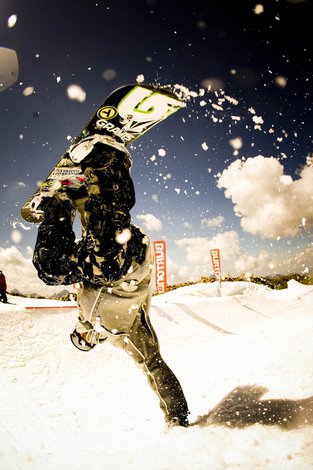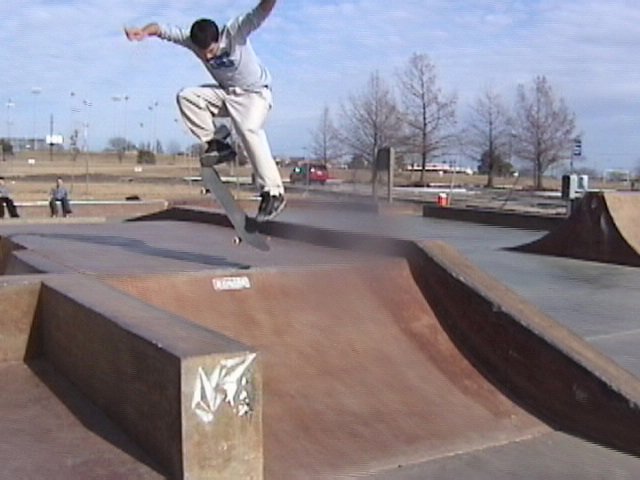Here's part 3 of my A - Z of snowboard tricks
halfpipe
What Is A Halfpipe,
And What Is It Used For?
In snowboarding, a
halfpipe is a dished area between 1.5 and 3 meters deep, 10 to 20 meters wide,
and 50 to 100 meters long, with rounded sides and a flat bottom. they are used
by beginner and professional alike as the basis of many tricks.

The areas defined in a halfpipe are: the flat, the flat area at the bottom; the
verticals, the upright sides of the halfpipe on each side, just below the lip
of the pipe; transitions, this is the transitional area going from the flat to
the walls; the platform/deck, the area above the vertical that is horizontal,
or flat; the entry ramp, this is the starting point.
Coming from anywhere on the deck or entry ramp speed is easily obtained using
gravity and momentum to perform some of the most difficult tricks in the world.
The sides are easily used for the purpose of jumping, spins, flips, or any
combination of tricks a person could imagine or attempt.
handplant
Handplants In
Snowboarding
Due to the many
similarities in the sports, many skateboarding and surfing tricks were borrowed
from the multitudes available. One of these was the handplant. This is where
the rider does a handstand on the lip of the halfpipe, quarterpipe, or most
anything that has a suitable situation to complete the maneuver. Variations of this
maneuver are very common, creating special combos, or leading into another
trick, here are a few of the more popular variations.
Eggplant: The rider handplants in a 180 degree invert using the leading hand,
using a backside rotation.

McEgg: Rider plants with the front hand on the wall and then rotates to the
backside 540 degrees to land the trick riding forward.
Elguerial: The rider approaches the lip fakie (backward from normal stance),
the rearward hand is planted, then a 360 degree backside rotation is made to
land the rider going forward.
These are only a few of the more common tricks from the arsenal that can be
started or done from a handplant. There are a lot more that are recognized and
defined, with other variations being developed every day.
jib
What Jib Means In
Snowboarding
In snowboarding the
term jib is used both as a noun and a verb, depending upon what the person is
talking about. Also known as "Bonk" or "Tap", it is usually
used when discussing freeride, or freestyle snowboarding.
When used as a noun, it referrs to any physical object, platform, wall, or
obstacle, etc., that is used to jump up on, or over, whether man-made or
natural. Most anything qualifies as a jib, with this loose of a term, trees,
curbs, rocks, will qualify, it doesn't matter. If the snowboarder can use it,
it is a jib.

With the above definition in mind, when a boarder uses a jib to perform a
trick, or maneuver, he is said to be jibbing, or perhaps a person could ask
"Do you know how to jib?".
The snowboard that is used to perform the tricks while jibbing is often
referred to as a jibstick.
nollie
Nollie
The nollie is the
basically the same thing as an ollie, except you are doing it off the nose as
opposed to the tail. Almost the same actions are performed, but because you are
doing them in the direction you’re going, you increase the difficulty and your
chances of crashing.

It’s best to try this on a day when conditions are good. Speed is important,
but don’t go to fast or you’ll find your head in the snow before you know it.
Lean forward over the nose of the board, being careful not to catch an edge.
You almost want to drive the nose of your board down as you do the following
things, almost at the same time. As hard as you can, pull your back foot up,
making the front of your board act like a spring. Pull up your front foot just
after that, leveling out your board and bringing both knees up as high as you
can, trying to almost bring them up to your chest. Lean back, and land it.
quarterpipe
Quarterpipe, What's
That For?
In a nutshell, a
quarterpipe is a ramp for skateboarders, and snowboarders. It is a large curved
surface that resembles one side of a halfpipe. It can be used to launch the
boarder into the air to perform tricks and stunts or the edges can be used for
grinding. The wider and larger the quarterpipes allow for more complicated
tricks, and the smaller ones are often combined to form a series of jumps, a
small halfpipe, or what is referred to as a spine ramp. This is where two
quarter pipes are placed back to back.
Using a quarter pipe allows for a lot of versatility in the configurations, and
virtually unlimited combinations for course changes and variations.
Quarterpipes are used in virtually every extreme sport because they provide an
outstanding opportunity to "get air" and perform more difficult, and
impressive, stunts.

Comments